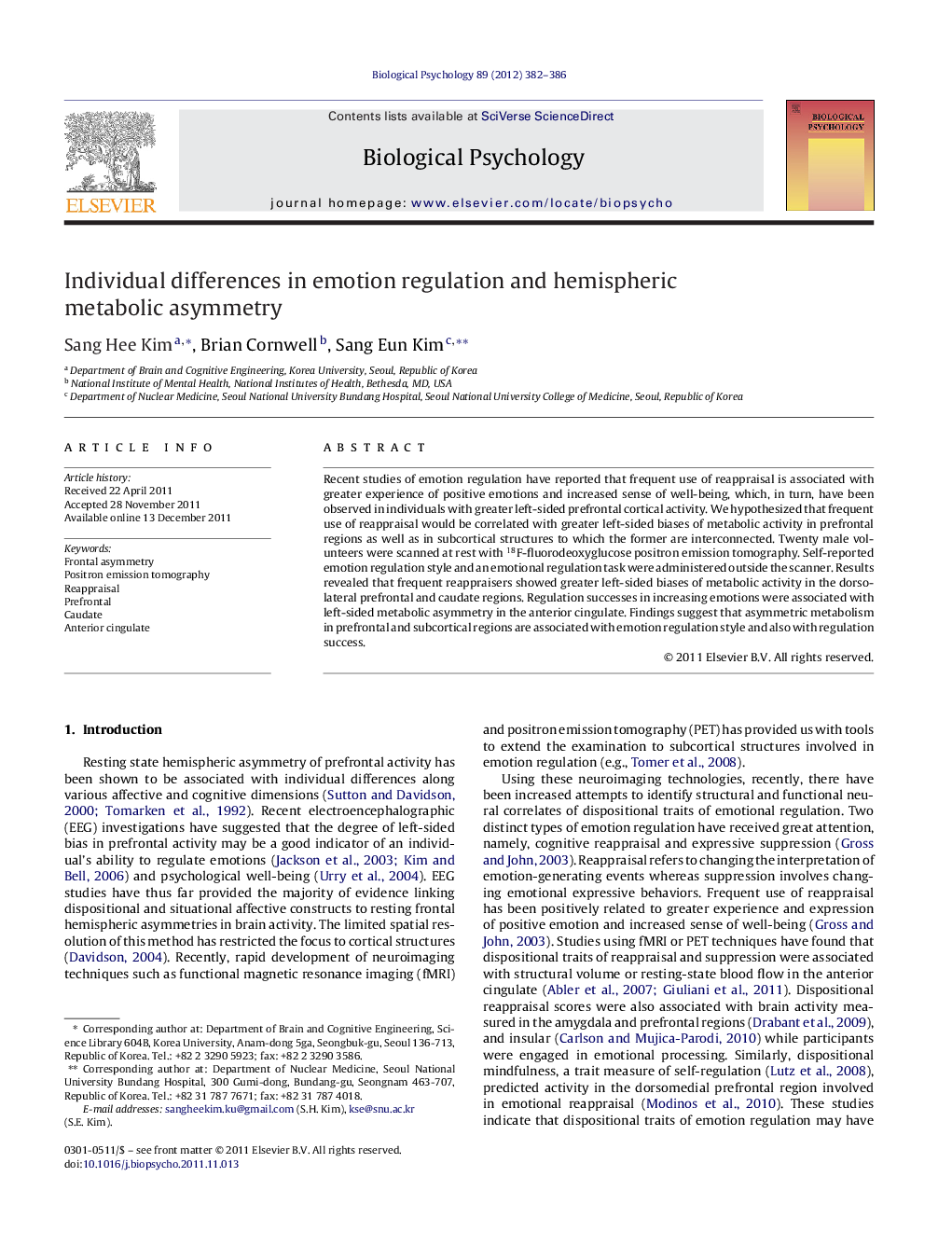Recent studies of emotion regulation have reported that frequent use of reappraisal is associated with greater experience of positive emotions and increased sense of well-being, which, in turn, have been observed in individuals with greater left-sided prefrontal cortical activity. We hypothesized that frequent use of reappraisal would be correlated with greater left-sided biases of metabolic activity in prefrontal regions as well as in subcortical structures to which the former are interconnected. Twenty male volunteers were scanned at rest with 18F-fluorodeoxyglucose positron emission tomography. Self-reported emotion regulation style and an emotional regulation task were administered outside the scanner. Results revealed that frequent reappraisers showed greater left-sided biases of metabolic activity in the dorsolateral prefrontal and caudate regions. Regulation successes in increasing emotions were associated with left-sided metabolic asymmetry in the anterior cingulate. Findings suggest that asymmetric metabolism in prefrontal and subcortical regions are associated with emotion regulation style and also with regulation success.
Resting state hemispheric asymmetry of prefrontal activity has been shown to be associated with individual differences along various affective and cognitive dimensions (Sutton and Davidson, 2000 and Tomarken et al., 1992). Recent electroencephalographic (EEG) investigations have suggested that the degree of left-sided bias in prefrontal activity may be a good indicator of an individual's ability to regulate emotions (Jackson et al., 2003 and Kim and Bell, 2006) and psychological well-being (Urry et al., 2004). EEG studies have thus far provided the majority of evidence linking dispositional and situational affective constructs to resting frontal hemispheric asymmetries in brain activity. The limited spatial resolution of this method has restricted the focus to cortical structures (Davidson, 2004). Recently, rapid development of neuroimaging techniques such as functional magnetic resonance imaging (fMRI) and positron emission tomography (PET) has provided us with tools to extend the examination to subcortical structures involved in emotion regulation (e.g., Tomer et al., 2008).
Using these neuroimaging technologies, recently, there have been increased attempts to identify structural and functional neural correlates of dispositional traits of emotional regulation. Two distinct types of emotion regulation have received great attention, namely, cognitive reappraisal and expressive suppression (Gross and John, 2003). Reappraisal refers to changing the interpretation of emotion-generating events whereas suppression involves changing emotional expressive behaviors. Frequent use of reappraisal has been positively related to greater experience and expression of positive emotion and increased sense of well-being (Gross and John, 2003). Studies using fMRI or PET techniques have found that dispositional traits of reappraisal and suppression were associated with structural volume or resting-state blood flow in the anterior cingulate (Abler et al., 2007 and Giuliani et al., 2011). Dispositional reappraisal scores were also associated with brain activity measured in the amygdala and prefrontal regions (Drabant et al., 2009), and insular (Carlson and Mujica-Parodi, 2010) while participants were engaged in emotional processing. Similarly, dispositional mindfulness, a trait measure of self-regulation (Lutz et al., 2008), predicted activity in the dorsomedial prefrontal region involved in emotional reappraisal (Modinos et al., 2010). These studies indicate that dispositional traits of emotion regulation may have distinct resting and activity-dependent neurobiological correlates. To our knowledge, however, no previous studies have examined relationships between prefrontal and subcortical asymmetry and individual differences in emotion regulation.
Based on previous research on hemispheric asymmetry and emotional experience, we hypothesized that individuals who use reappraisal strategies more frequently in everyday life would show greater left-sided biases in subcortical as well as lateral prefrontal metabolism. Because reappraisal was also associated with self-reported measures of regulation success (Gross and John, 2003), we also hypothesized that individuals who use reappraisal strategies more frequently would show greater success in a laboratory emotion regulation task.
To examine these hypotheses, we obtained 18F-fluorodeoxyglucose (FDG) PET images and calculated both prefrontal and subcortical metabolic asymmetry. We assessed dispositional traits of emotion regulation using the Emotion Regulation Questionnaire (ERQ) (Gross and John, 2003). We also assessed individual differences in regulation success using a laboratory reappraisal task (Kim and Hamann, 2007 and Ochsner et al., 2004). Regulation success was defined as reappraisal-induced changes in self-reports of emotional intensity elicited by colored photographs depicting emotional contents (Banks et al., 2007 and Kober et al., 2010). Personality traits, such as neuroticism and extraversion, have been associated with both emotion regulation measures (John and Gross, 2004) and asymmetry in prefrontal activity (Deckersbach et al., 2006, Gale et al., 2001, Hagemann et al., 1999 and Minnix and Kline, 2004); thus, we obtained and controlled for trait levels of neuroticism and extraversion in our statistical examination.


